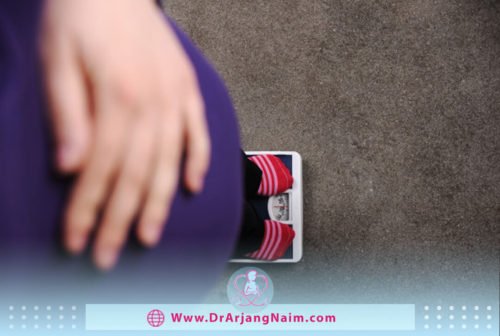The baby bump is the enlarged abdomen of a pregnant woman. There is no doubt that when any woman realizes that she is pregnant, her body will soon change shape, especially in the abdomen . Pregnancy varies from person to person. Many factors affect a large or small, wide, or neat abdomen.
Baby bump progression
Baby bump progression varies from person to person. As a general timeline, the baby is about the size of a lemon at 12 weeks. By the 16th week, the baby may be the size of an avocado. At 20 weeks, it is the size of a banana and 24 times the size of a cantaloupe. Remember that the body also contains amniotic fluid and excess fat needed to feed the baby.
What affects baby bump size?
If you are a first-time mother, you will probably notice that your waist is a little thicker by about 11 weeks. At about 13 weeks, you may see a small bump. If you are already a mother, you may start showing up sooner. This is because your uterine and abdominal muscles may be stretched from your previous pregnancy. In the early days of pregnancy, your uterus is pear-shaped. During the first 12 weeks, it gradually thickens until it is about the size of a grapefruit. This is when your bumps may start to form.
At 16 weeks gestation, your uterus is stretched to fit your growing baby. This is when your bump may actually be shown to others. Many factors affect the size of the abdomen. These factors include:
- Core strength: The core muscles are important muscles and are vital for things like posture and balance. Our core also affects baby bump size. If someone is very fit and has done many exercises like Pilates and has a strong core, their rectus muscles, which are the abdominal muscles in the front, are tight. Strong abdominal muscles as the growing uterus stay close to the body core, making the abdomen smaller.
On the other hand, if the main muscles are stretched from a previous pregnancy, the bulge of the second or third child of pregnancy may appear larger. - Weight and height: Women’s bodies are different and reflect different sizes of bumps. If a woman is taller, her pregnancy may not show as much as that of a shorter person. Pre-pregnancy weight in women can also play a role in the size of the bulge. Doctors usually recommend gaining about 25 to 35 pounds during pregnancy, which varies from woman to woman based on pre-pregnancy weight.
- Hormones and stage of pregnancy: Normally, as the pregnancy progresses, the bulge begins to grow. Most pregnant women do not show that they are pregnant before about 16 weeks. During the first trimester of pregnancy, a woman may experience morning sickness, which can lead to decreased appetite and vomiting, leading to weight loss. Flatulence caused by progesterone can also cause changes in the shape of the abdomen.
Facts about baby bump
The baby bump is an important issue in pregnant women, and its size may be a concern for mothers. There are facts about it that can help mothers to have a more comfortable pregnancy.
It probably won’t be noticeable at first
Of course, as soon as any woman realizes that she is pregnant, she will feel completely different inside, but her appearance will not change. In the first 4 weeks of pregnancy, the baby is still small, and it is the size of a poppy seed, and most likely, the bulge of the abdomen will not be visible until it is three months old.
When start to show, the belly grows fast
At the beginning of pregnancy, the changes are usually not obvious, but it has a high growth rate when the abdomen begins to grow. Abdominal skin usually begins to stretch between 13 and 21 weeks. When the abdomen starts to stretch around the 35week, the veins may become dark and prominent.
Vibrating movements begin
If you feel fluttering, it is due to the twisting and movements of the fetus. This early movement, called quickening, usually begins at 4 or 5 months of pregnancy. From then on, the child is more active. At six months, the fetus’s legs may shake, and at 28 weeks, the doctor wants to start counting kicks or the baby’s movements to ensure everything goes as expected.
The dark line that’s forming is normal
The brown line on the abdomen, LineaNigra, has been visible for about 23 weeks. It is completely normal and will disappear a few months after delivery. If you want to be less prominent, try to keep the abdomen covered when you go out. Sun exposure can cause skin discoloration during pregnancy.
The inside of the abdomen is warm and cozy, but not soundproof
By 16 weeks, the baby’s ears are large enough to hear sounds. By week 26, the baby’s brain has grown to some extent so the baby can respond to stimuli. Do not be surprised if the baby kicks a little when you talk to him or her. May think of finding a special song for a child. Although there is no reason to play the music that raises a child’s IQ, sharing favorite songs can be a fun experience.
Baby loves to touch the abdomen
Touching, stroking, or holding the hand on the abdomen not only makes the baby feel warm, but the baby may also feel good. The fetus responds by placing its hand on the abdomen and is more likely to respond to familiar touches, such as the mother. Touching the abdomen can irritate the baby, especially when start counting strokes.
Measuring a little small or big is usually harmless
At each prenatal visit, the doctor uses a tape measure to check fundal height (distance from the pubic bone to the top of the uterus). This number in centimeters is approximately equal to the weeks in which it is located. 1 or 2 cm in both directions is not a concern, and this does not mean that the baby is not growing fast enough or is too large for vaginal delivery.
A rapidly growing abdomen can make things a little uncomfortable in the end. The baby rises from about 2 pounds at the end of the second trimester to 6 to 9 pounds at the end of the third trimester. As the baby takes up more space in the abdomen, the mother may start to notice some not-so-fun changes.
She may feel severe pain from stretching the round ligaments as the bulge grows. Heartburn can also be a problem because the expanding uterus puts pressure on the abdomen. Do not be surprised if you feel more severe blows in the last weeks of pregnancy because the abdomen’s space is too small for the baby. But the good news is that the baby and the mother are almost at the finish line. It won’t be long before the mother hugs her baby.
Round ligament pain
One of the complications that pregnancy causes are round ligament pain. An enlarged abdomen usually causes it. It is important to note that round ligament pain in pregnancy can start any time in the second trimester or after 12 weeks. It is individual and related to things like the size of the baby, the way it is carried, and the mother’s body.
5 Concerns about Baby Bump

Pregnancy is a stressful time for most mothers. One of these concerns is the state of her ever-growing baby bump. A woman cannot see inside her abdomen; the only sign she can see is a fetus’s bulge. These concerns include:
- Carrying Small: Eat well, exercise, and have regular prenatal checkups. However, people often say that belly size seems small for gestational age.
The doctor or midwife will check the baby’s size in relation to the date of birth and the abdomen’s size with regular screenings, including a measurement of the abdomen at each visit after reaching 15 weeks to 20 weeks. This measure tells them how much the abdomen has grown. The normal rate of growth when the abdomen begins to grow is about 1 cm per week. If the abdominal muscles are strong and the pregnant mother is tall, the baby Bump will show less protrusion. - Carrying Large: The larger abdomen may appear due to the baby’s position in the womb. Usually, in pregnancies other than the first, pregnancy occurs much earlier. After a pregnancy, the muscles are slightly stretched and more easily exposed to the expanding uterine pressure. In rare cases, the large abdomen is due to excess amniotic fluid (polyhydramnios), conditions requiring more care.
- Carrying High: The pregnant mother’s abdomen may look as if she has swallowed a basketball. In this case, the abdomen looks like the mother carrying their babies up front and high. It is not uncommon for a baby to be placed in the womb as described. Some women do all their pregnancies just as easily from start to finish, especially those with very strong abdominal muscles. The old belief that the shape of the abdomen indicates the sex of the baby is not scientific.
- Carrying Low: Low carrying can be uncomfortable. Some pregnant mothers are made to bring it down. During the second or third pregnancy, the muscles and ligaments that support the growing uterus are stretched and weakened and cannot support the growing uterus as before. Carrying Low may be a sign of preterm birth. The biggest problem with low carrying is that it puts pressure on the waist. Exercises such as pelvic tilt can reduce discomfort or pain in the lower back.
- Carrying Wide: A wide abdomen may mean that the baby is in a transverse position. This will not be a problem until the baby is born. A cesarean section should deliver the baby if the baby’s head is not down at birth. If a pregnant mother is overweight, she may feel that she is carrying more side by side than other pregnant women.
Enjoy your bump

As exciting as pregnancy is, a baby Bump can cause a mother to lose confidence. Here are some tips to boost confidence:
- Do not weigh regularly
- Don’t neglect maternity fashion
- Makeup and straighten hair
- Believe when others say you are beautiful
- Do exercise
The bottom line
Changing from a flat stomach to a baby Bump can be a little stressful while being exciting. Pregnant mothers should not be sensitive to the size of their abdomen. Regular visits by an obstetrician completely control the condition of the mother and fetus.
Dr. Arjang Naim MD and his professional team check the abdomen’s size at each visit of the pregnant mother and make the necessary recommendations. Therefore, the mother can spend her pregnancy in complete peace.
Additional questions
The black line appears due to high levels of hormones such as estrogen and progesterone during pregnancy, which can make some areas of the skin appear darker. In most people, the black line becomes so dark that it is visible in the second trimester.
- Does a small bump mean a small baby?
No one, not even a doctor or midwife, can simply tell the size of a baby by looking at the bump. Since the body changes at every stage of pregnancy, you cannot compare yourself to other women. Every pregnancy is unique.
- What are the signs of a big baby?
Fundal height greater than expected can be a sign of fetal macrosomia.
Having too much amniotic fluid (the fluid that surrounds and protects the baby during pregnancy) may be a sign that the fetus is larger than average.
- What causes preterm birth?
A preterm birth is when a baby is born too early, before the 37th week of pregnancy is completed. Common causes of premature birth include multiple pregnancies, infections, and chronic diseases such as diabetes and high blood pressure.
- Who kicks more, boy or girl?
Research shows that girls kick as much as boys. Babies who kick a lot in the womb are also more active after birth.
References:
https://www.verywellfamily.com/concerns-about-your-pregnant-belly-2759765
https://www.babycentre.co.uk/x25006275/when-will-i-look-pregnant
https://www.whattoexpect.com/pregnancy/pregnancy-health/things-to-know-about-your-baby-bump/
https://www.whattoexpect.com/pregnancy/pregnancy-health/things-to-know-about-your-baby-bump/
https://www.healthline.com/health/pregnancy/when-do-you-start-to-show#takeaway




